 W
WAriconium was a road station of Roman Britain mentioned in Iter XIII of the Iter Britanniarum of the Antonine Itineraries. It was located at Bury Hill in the parish of Weston under Penyard, about 3 miles (5 km) east of Ross on Wye, Herefordshire, and about 15 miles (24 km) southeast of Hereford. The site existed prior to the Roman era, and then came under Roman control. It was abandoned, perhaps shortly after 360, but precisely when and under what circumstances is unknown.
 W
WAn arrastra is a primitive mill for grinding and pulverizing (typically) gold or silver ore. Its simplest form is two or more flat-bottomed drag stones placed in a circular pit paved with flat stones, and connected to a center post by a long arm. With a horse, mule or human providing power at the other end of the arm, the stones were dragged slowly around in a circle, crushing the ore. Some arrastras were powered by a water wheel; a few were powered by steam or gasoline engines, and even electricity.
 W
WArsenical bronze is an alloy in which arsenic, as opposed to or in addition to tin or other constituent metals, is added to copper to make bronze. The use of arsenic with copper, either as the secondary constituent or with another component such as tin, results in a stronger final product and better casting behavior.
 W
WAxe-monies refer to bronze artifacts found in both western Mesoamerica and the northern Andes. Based on ethnohistorical, archaeological, chemical, and metallurgical analyses, the scholars Hosler, Lechtman and Holm have argued for their use in both regions through trade. In contrast to naipes, bow-tie- or card-shaped metal objects which appear in the archaeological record only in the northern Andean coastal region, axe-monies are found in both Mesoamerican and Andean cultural zones. More specifically, it is argued that the system of money first arose on the north coast of Peru and Ecuador in the early second millennium CE. In both regions, bronze was smelted, likely by family units, and hammered into thin, axe-shaped forms and bundled in multiples of five, usually twenty. As they are often found in burials, it is likely that in addition to their presumed economic use, they also had ceremonial value.
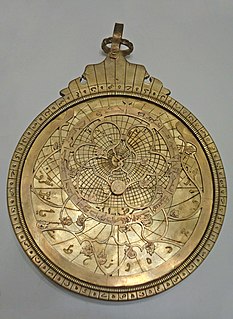 W
WBrass is an alloy of copper and zinc, in proportions which can be varied to achieve varying mechanical and electrical properties. It is a substitutional alloy: atoms of the two constituents may replace each other within the same crystal structure.
 W
WThe use of bronze dates from remote antiquity. This important metal is an alloy composed of copper and tin, in proportion which vary slightly, but may be normally considered as nine parts of copper to one of tin. Other ingredients which are occasionally found are more or less accidental. The result is a metal of a rich golden brown colour, capable of being worked by casting — a process little applicable to its component parts, but peculiarly successful with bronze, the density and hardness of the metal allowing it to take any impression of a mould, however delicate. It is thus possible to create ornamental work of various kinds.
 W
WThe Cape York meteorite, also known as the Innaanganeq meteorite, is one of the largest known iron meteorites, classified as a medium octahedrite in chemical group IIIAB. In addition to many small fragments, at least eight large fragments with a total mass of 58 tons have been recovered, the largest weighing 31 tonnes. The meteorite is loosely named after the location where the largest fragment was found: 23 miles (37 km) east of Cape York, in Savissivik, Meteorite Island, Greenland.
 W
WCasting is a manufacturing process. It is a process in which a liquid metal is somehow delivered into a mold that contains a negative impression of the intended shape. The metal is poured into the mold through a hollow channel called a sprue. The metal and mold are then cooled, and the metal part is extracted. Casting is most often used for making complex shapes that would be difficult or uneconomical to make by other methods.
 W
WCorinthian bronze, also named Corinthian brass or æs Corinthiacum, was a highly valuable metal alloy in classical antiquity. It is thought to be an alloy of copper with gold or silver, although it has also been contended that it was simply a very high grade of bronze, or a kind of bronze that was manufactured in Corinth. It is referred to in various ancient texts, but no certain examples of Corinthian bronze exist today. However, it has been increasingly suggested that a number of artefacts previously described as niello in fact use a technique of patinated metal that may be the same as Corinthian bronze and is similar to the Japanese Shakudō.
 W
WDe la Pirotechnia is considered to be the first printed book on metallurgy to have been published in Europe. It was written in Italian and first published in Venice in 1540. The author was Vannoccio Biringuccio, a citizen of Siena, Italy, who died before it was published. Further editions were published in 1550, 1558, 1559, and 1678, with a (sloppy) French translation by Jacques Vincent being published in 1556, 1572, and 1627. Parts were translated into Latin, English and Spanish at various times in the 1550s and 1560s, generally without acknowledgement. The second book on metallurgy, De re metallica, was written in Latin by Georgius Agricola, and published in 1556.
 W
WDe re metallica is a book in Latin cataloguing the state of the art of mining, refining, and smelting metals, published a year posthumously in 1556 due to a delay in preparing woodcuts for the text. The author was Georg Bauer, whose pen name was the Latinized Georgius Agricola. The book remained the authoritative text on mining for 180 years after its publication. It was also an important chemistry text for the period and is significant in the history of chemistry.
 W
WThe Dhar iron pillar is a now-fragmented iron column located in the Dhar town of Madhya Pradesh, India. The exact origins of the pillar are unknown, but according to the local tradition, it was a victory column erected by the 11th century Paramara king Bhoja.
 W
WFerrous metallurgy is the metallurgy of iron and alloys. It began far back in prehistory. The earliest surviving iron artifacts, from the 4th millennium BC in Egypt, were made from meteoritic iron-nickel. It is not known when or where the smelting of iron from ores began, but by the end of the 2nd millennium BC iron was being produced from iron ores from at least Greece to India, and more controversially Sub-Saharan Africa. The use of wrought iron was known by the 1st millennium BC, and its spread marked the Iron Age. During the medieval period, means were found in Europe of producing wrought iron from cast iron using finery forges. For all these processes, charcoal was required as fuel.
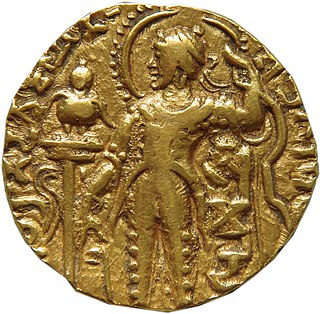 W
WThe history of metallurgy in the Indian subcontinent began prior to the 3rd millennium BCE and continued well into the British Raj. Metals and related concepts were mentioned in various early Vedic age texts. The Rigveda already uses the Sanskrit term Ayas(आयस) (metal). The Indian cultural and commercial contacts with the Near East and the Greco-Roman world enabled an exchange of metallurgic sciences. With the advent of the Mughals, India's Mughal Empire further improved the established tradition of metallurgy and metal working in India.
 W
WThe Iron & Steel Museum of Alabama, also known as the Tannehill Museum, is an industrial museum that demonstrates iron production in the nineteenth-century Alabama located at Tannehill Ironworks Historical State Park in McCalla, Tuscaloosa County, Alabama. Opened in 1981, it covers 13,000 square feet (1,200 m2).
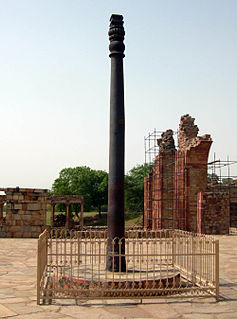 W
WThe iron pillar of Delhi is a structure 23 feet 8 inches high with 16 inches diameter that was constructed by Chandragupta II, and now stands in the Qutb complex at Mehrauli in Delhi, India. It is famous for the rust-resistant composition of the metals used in its construction. The pillar weighs over three tonnes and is thought to have been erected elsewhere, perhaps outside the Udayagiri Caves, and moved to its present location early in the Delhi Sultanate.
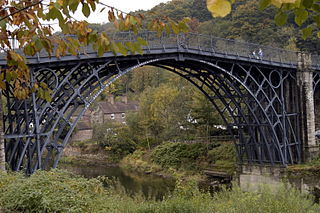 W
WAn ironmaster is the manager, and usually owner, of a forge or blast furnace for the processing of iron. It is a term mainly associated with the period of the Industrial Revolution, especially in Great Britain.
 W
WThe Copper Age, also called the Eneolithic or the Chalcolithic Age, has been traditionally understood as a transitional period between the Neolithic and the Bronze Age, in which a gradual introduction of the metal took place, while stone was still the main resource utilized. Recent archaeology has found that the metal was not introduced so gradually and that this entailed significant social changes, such as developments in the type of habitation, long-distance trade, and copper metallurgy.
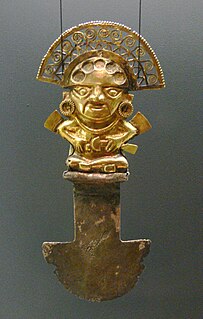 W
WMetallurgy in pre-Columbian America is the extraction, purification and alloying of metals and metal crafting by Indigenous peoples of the Americas prior to European contact in the late 15th century. Indigenous Americans have been using native metals from ancient times, with recent finds of gold artifacts in the Andean region dated to 2155–1936 BCE, and North American copper finds dated to approximately 5000 BCE. The metal would have been found in nature without need for smelting, and shaped into the desired form using hot and cold hammering without chemical alteration or alloying. To date "no one has found evidence that points to the use of melting, smelting and casting in prehistoric eastern North America." In South America the case is quite different. Indigenous South Americans had full metallurgy with smelting and various metals being purposely alloyed. Metallurgy in Mesoamerica and Western Mexico may have developed following contact with South America through Ecuadorian marine traders.
 W
WThe emergence of metallurgy in pre-Columbian Mesoamerica occurred relatively late in the region's history, with distinctive works of metal apparent in West Mexico by roughly AD 800, and perhaps as early as AD 600. Metallurgical techniques likely diffused northward from regions in Central or South America via maritime trade routes; recipients of these metallurgical technologies apparently exploited a wide range of material, including alloys of copper-silver, copper-arsenic, copper-tin and copper-arsenic-tin.
 W
WDuring the Middle Ages from the 5th century AD to the 16th century, Western Europe saw a blooming period for the mining industry. The first important mines here were those at Goslar in the Harz mountains, taken into commission in the tenth century. Another famous mining town is Falun in Sweden where copper has been mined since the thirteenth century.
 W
WNonferrous Archaeometallurgy in the Southern Levant refers to the archaeological study of non-Iron-related metal technology in the region of the Southern Levant during the Chalcolithic period and Bronze Age from approximately 4500BC to 1000BC.
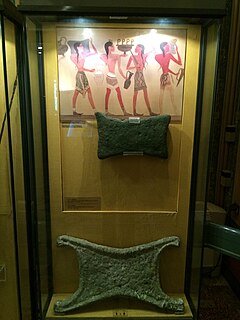 W
WOxhide ingots are metal slabs, usually of copper but sometimes of tin, produced and widely distributed during the Mediterranean Late Bronze Age (LBA). Their shape resembles the hide of an ox with a protruding handle in each of the ingot’s four corners. Early thought was that each ingot was equivalent to the value of one ox. However, the similarity in shape is simply a coincidence. The ingots' producers probably designed these protrusions to make the ingots easily transportable overland on the backs of pack animals. Complete or partial oxhide ingots have been discovered in Sardinia, Crete, Peloponnese, Cyprus, Cannatello in Sicily, Boğazköy in Turkey, Qantir in Egypt, and Sozopol in Bulgaria. Archaeologists have recovered many oxhide ingots from two shipwrecks off the coast of Turkey.
 W
WThe Wealden iron industry was located in the Weald of south-eastern England. It was formerly an important industry, producing a large proportion of the bar iron made in England in the 16th century and most British cannon until about 1770. Ironmaking in the Weald used ironstone from various clay beds, and was fuelled by charcoal made from trees in the heavily wooded landscape. The industry in the Weald declined when ironmaking began to be fuelled by coke made from coal, which does not occur accessibly in the area.
 W
WWootz steel is a crucible steel characterized by a pattern of bands and high carbon content. These bands are formed by sheets of microscopic carbides within a tempered martensite or pearlite matrix in higher carbon steel, or by ferrite and pearlite banding in lower carbon steels. It was a pioneering steel alloy invented in Southern India in the mid-1st millennium BC and exported globally.